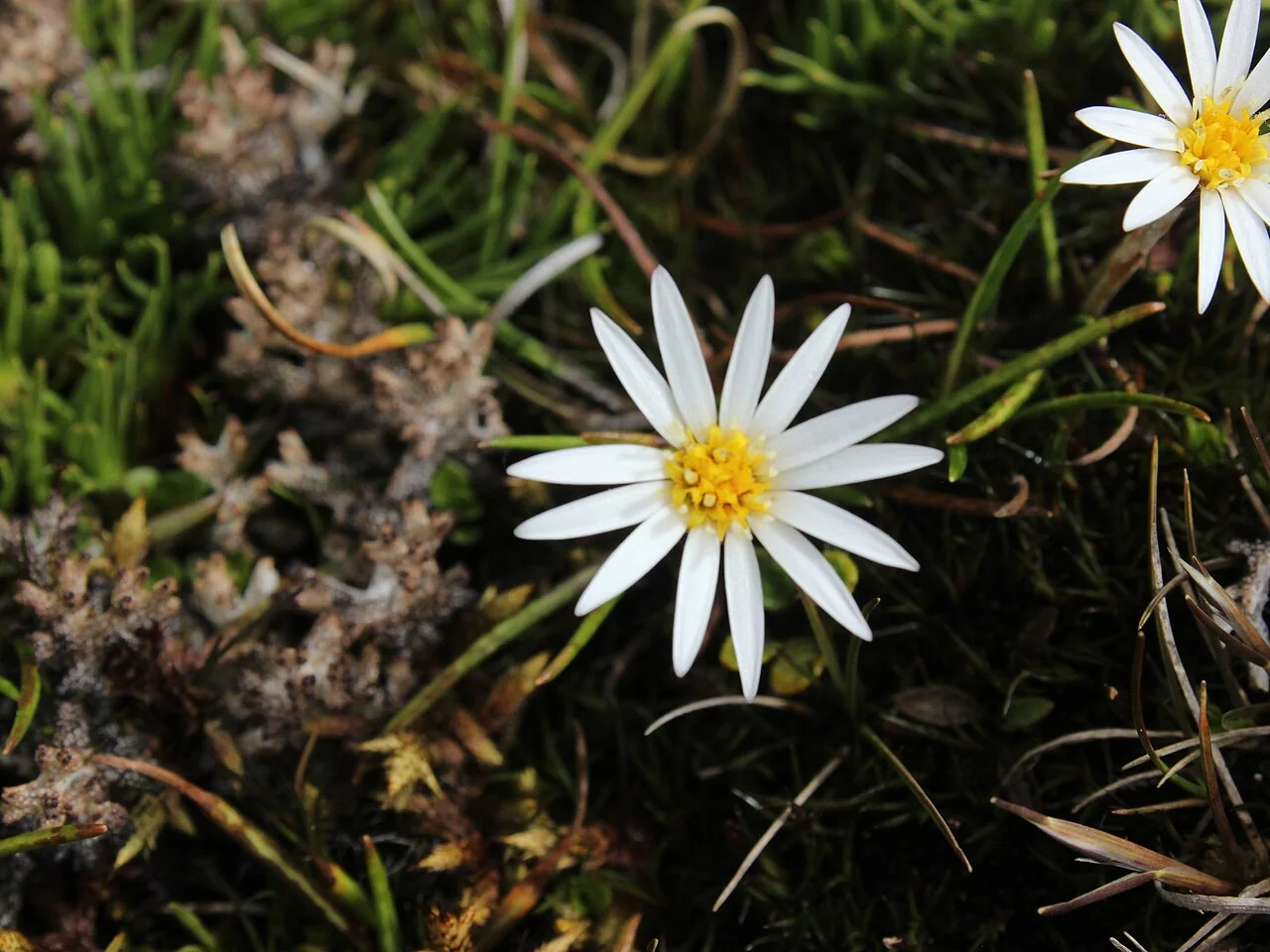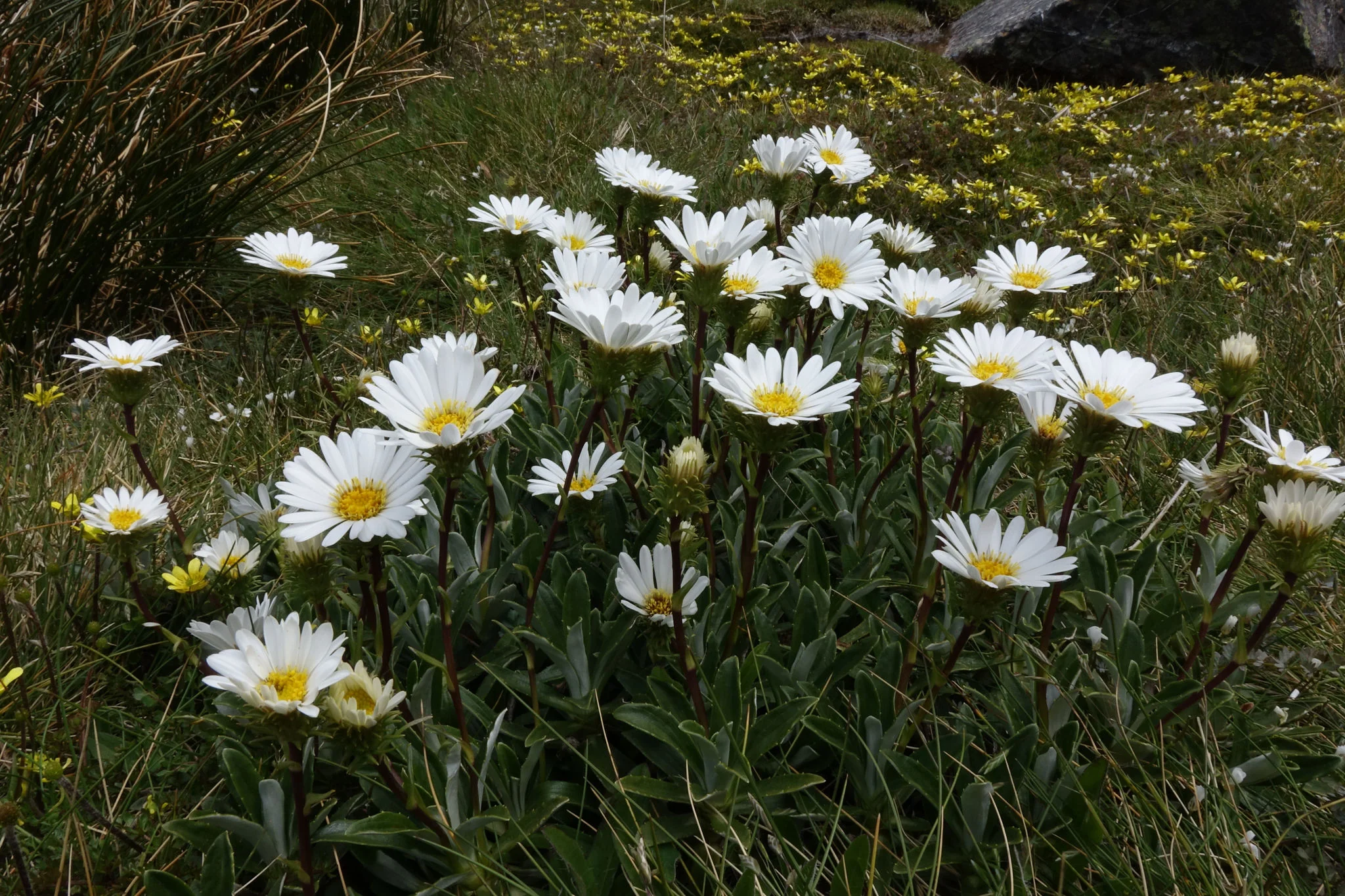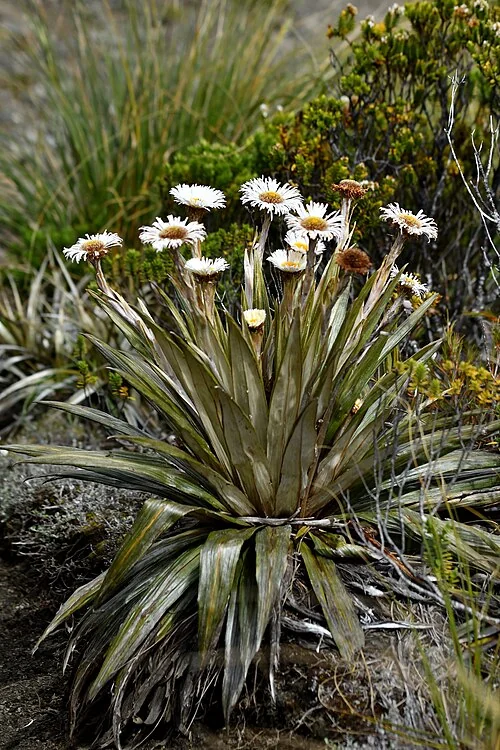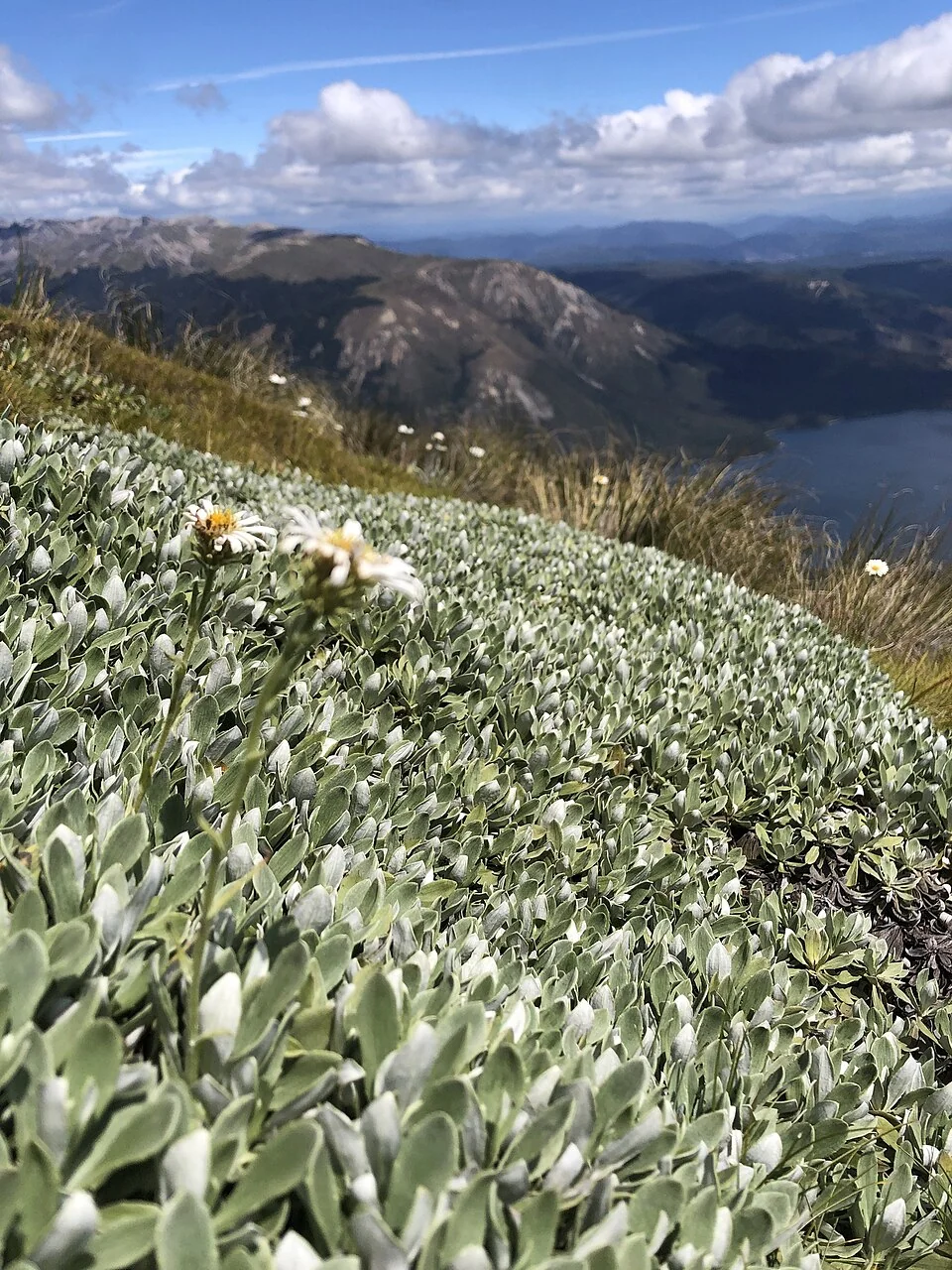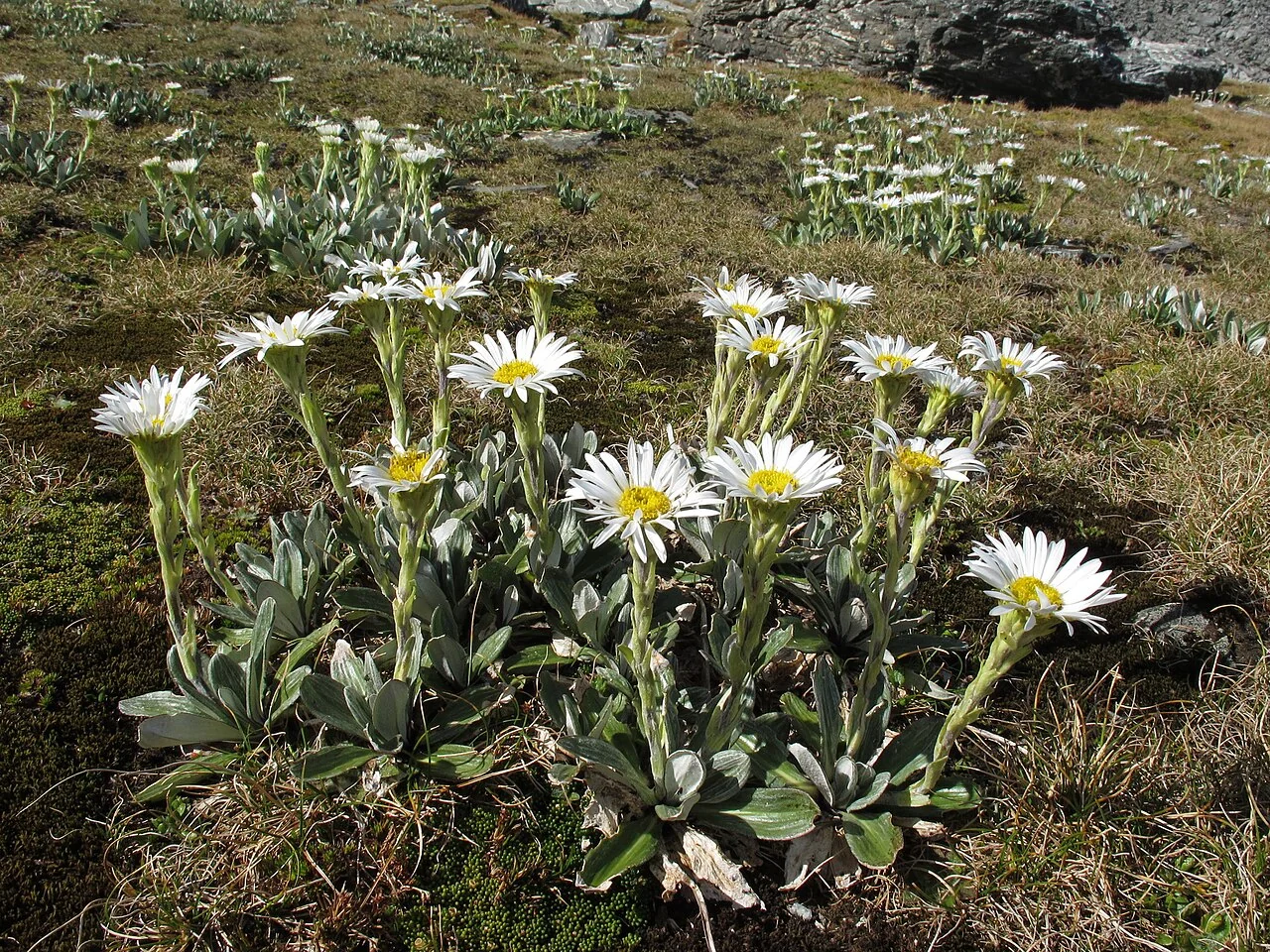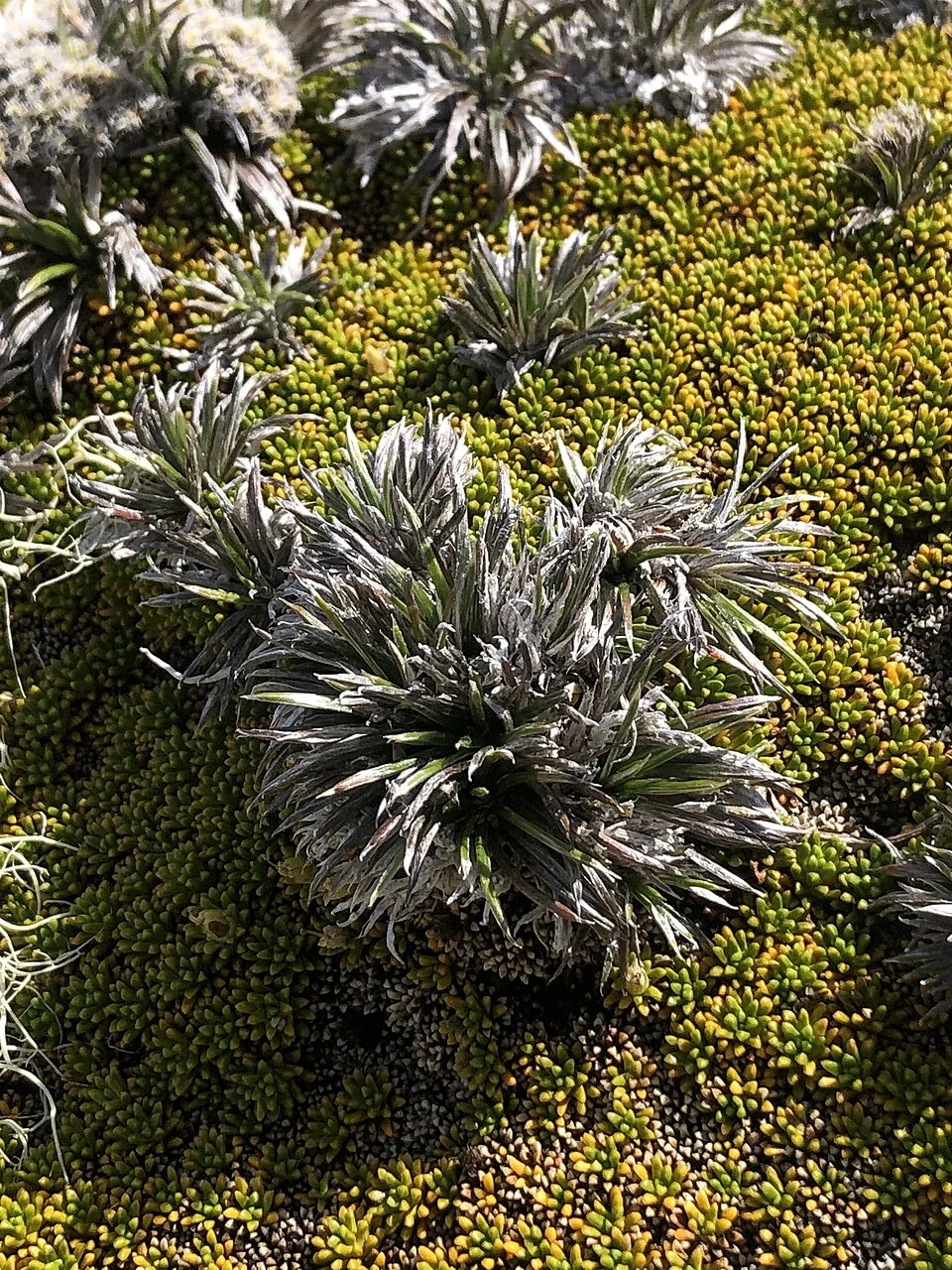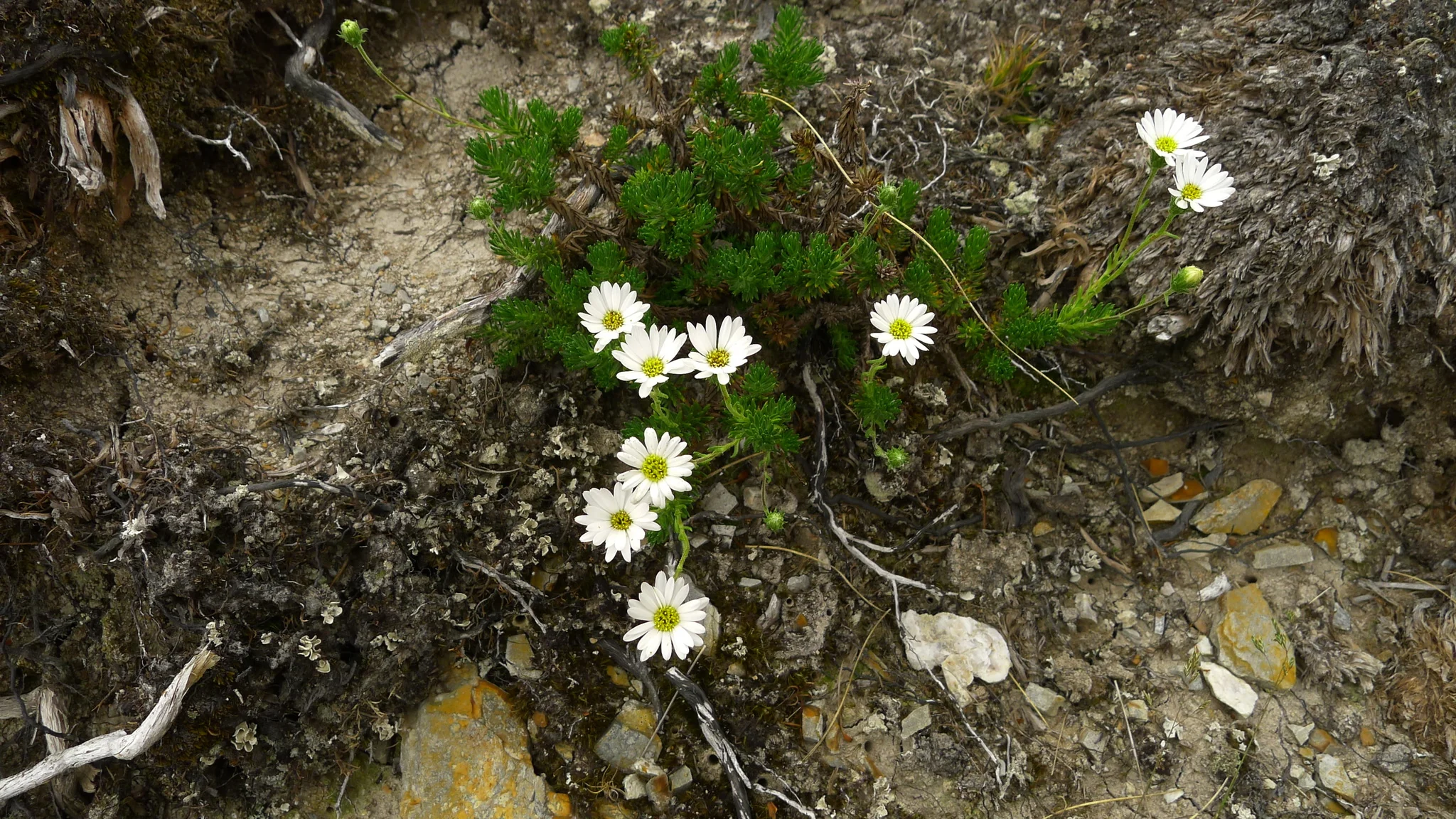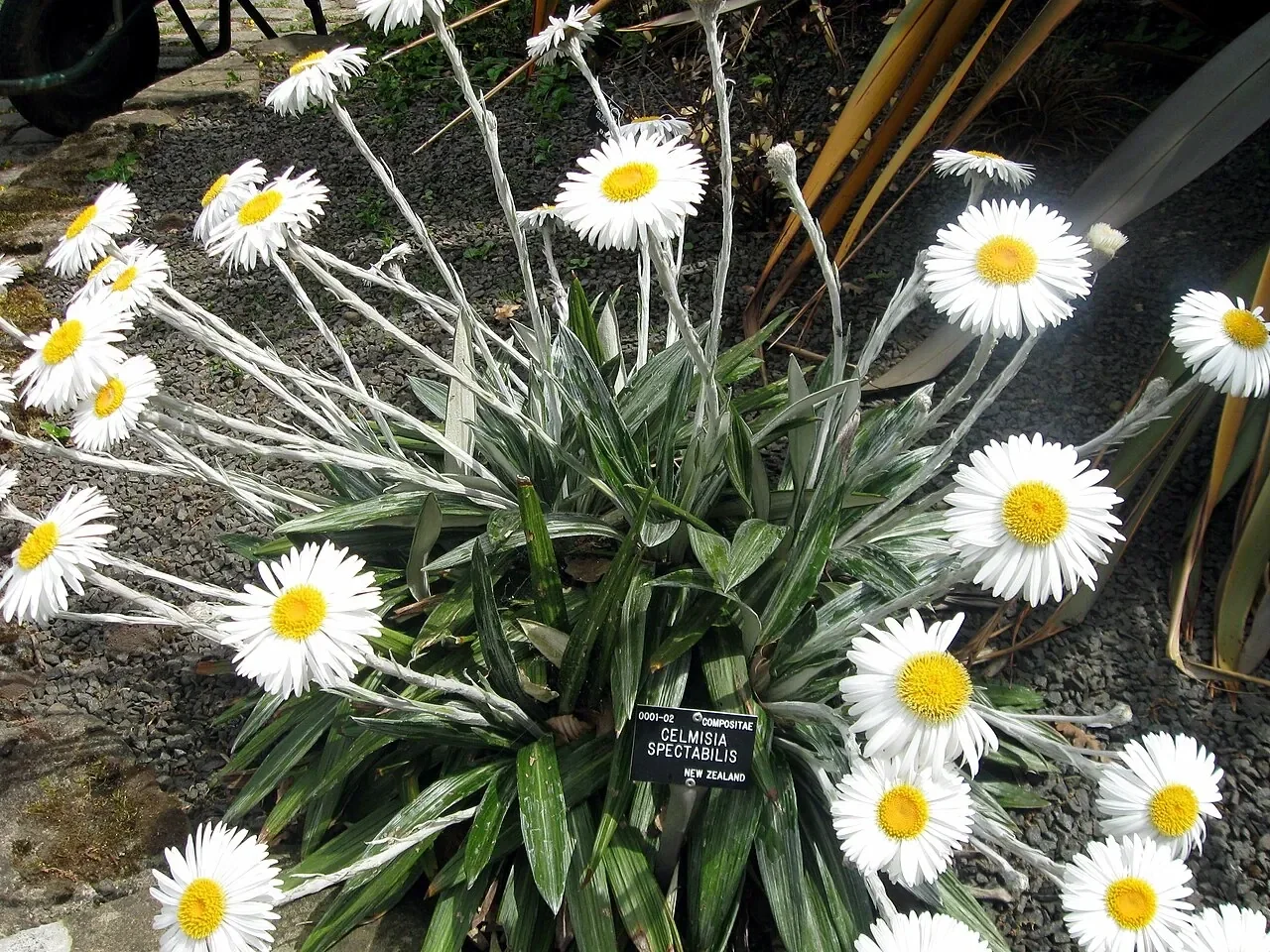
Cotton Daisy
Celmisia spectabilis
Introduction
Overview
Cotton Daisy ( Celmisia spectabilis ) is a spectacular alpine perennial distinguished by its silver-white felted leaves and brilliant white daisy flowers with golden centers. This remarkable mountain daisy forms distinctive rosettes of densely woolly foliage that provides protection against harsh alpine conditions, while producing stunning displays of flowers during summer months. Endemic to New Zealand's high country, Cotton Daisy represents one of the most ornamentally valuable and ecologically important members of the diverse Celmisia genus, offering both aesthetic appeal and crucial habitat for alpine pollinators.

The Cotton Daisy (scientific name: Celmisia spectabilis ) is a magnificent alpine perennial endemic to New Zealand's high country. This hardy plant forms striking rosettes of silvery-white, felted leaves topped with large, daisy-like flowers. Found in subalpine and alpine regions, particularly in tussock grasslands and rocky areas, it's renowned for its spectacular white blooms and distinctive woolly foliage that provides insulation against harsh mountain conditions. Understanding this remarkable alpine plant contributes to appreciation of New Zealand's unique high-altitude flora.
Quick Facts
| Scientific Name | Celmisia Spectabilis |
|---|---|
| Height | 30-60 cm |
| Spread | 60-100 cm |
| Water Needs | Low to moderate |
| Light | Full sun |
| Frost Tolerance | Excellent |
| Salt Tolerance | Poor |
| Growth Rate | Slow to moderate |
| Lifespan | Long |
Climate Best Suited to
Cotton Daisy ( Celmisia spectabilis ) thrives in cool, maritime climates with warm but not hot summers and fairly mild winters. Found naturally in montane to alpine regions throughout New Zealand's mountains, this hardy perennial is adaptable to various conditions but dislikes high humidity. It demonstrates excellent cold tolerance down to around -10°C, making it suitable for cultivation in cooler temperate regions. The plant prefers well-drained soils in full sun to partial shade positions.
Regional Suitability
| City | Climate Suitability |
|---|---|
| Whangārei | Ideal |
| Auckland | Ideal |
| Hamilton | Ideal |
| Tauranga | Ideal |
| Rotorua | Ideal |
| Gisborne | Ideal |
| New Plymouth | Ideal |
| Napier | Ideal |
| Whanganui | Ideal |
| Palmerston North | Ideal |
| Wellington | Ideal |
| Nelson | Ideal |
| Christchurch | Ideal |
| Dunedin | Ideal |
| Invercargill | Ideal |
Natural Habitat
Distribution and Environment
Celmisia spectabilis , or Cotton Daisy, is endemic to New Zealand, found primarily in the alpine and subalpine regions of both the North and South Islands. Its natural habitat includes tussock grasslands, herbfields, and rocky sites, typically at elevations up to 1,800 meters. While predominantly an alpine species, it can also be found in montane areas and, in some instances, descends to sea level on coastal cliffs in specific regions. This plant is known for its adaptability, thriving in various environments, including disturbed areas, and prefers moist, well-drained soil in sunny or semi-shaded locations.
Plant Conservation
Celmisia spectabilis , commonly known as cotton daisy or mountain daisy, is generally classified as "Not Threatened" in New Zealand. It is one of the most widespread species in the Celmisia genus and is endemic to New Zealand.
However, one subspecies, Celmisia spectabilis lanceolata, is considered "At Risk-Naturally Uncommon" according to the Department of Conservation NZTCS database.
Growing Requirements
Soil Requirements
Cotton Daisy ( Celmisia spectabilis ) requires excellent drainage to thrive, preferring moist but free-draining soils that never become waterlogged. The plant adapts to various soil types but performs best in slightly acidic to neutral soils with good organic content. Avoid heavy clay soils that retain moisture, as these can lead to root rot in this alpine species.
- Excellent drainage is absolutely essential
- Prefers slightly acidic to neutral pH (6.0-7.0)
- Thrives in well-composted, organically rich soils
- Avoid waterlogged or heavy clay soils
- Benefits from mulching with gravel or grit for drainage
Light Requirements
Cotton Daisy ( Celmisia spectabilis ) performs best in full sun positions, which promotes compact growth and abundant flowering. However, it can tolerate some afternoon shade, particularly in warmer climates or during the hottest summer months. In its natural alpine habitat, it receives intense sunlight at high altitudes with cool air temperatures.
- Full sun for optimal flowering and compact form
- Can tolerate light afternoon shade in hot climates
- At least 6 hours of direct sunlight daily
- Morning sun is particularly beneficial
Water Requirements
Once established, Cotton Daisy ( Celmisia spectabilis ) requires moderate watering, preferring consistent moisture without waterlogging. During establishment, regular watering is important, but mature plants are quite drought-tolerant. The key is to provide moisture while ensuring excellent drainage, mimicking its natural alpine environment.
- Moderate, consistent watering during growing season
- Reduce watering in winter months
- Drought-tolerant once fully established
- Never allow soil to become waterlogged
- Overhead watering can cause crown rot - water at soil level
Planting Guide
When to Plant
The best time to plant Celmisia spectabilis is during spring or autumn when soil temperatures are moderate and rainfall is reliable. This allows the plant to establish its root system before the stresses of summer heat or winter cold.
Site Selection
Choose a site that mimics its natural alpine habitat:
- Light: Full sun to partial shade. In hotter climates, it benefits from some afternoon shade to protect it from intense heat.
- Soil: This plant thrives in well-drained, gritty, or rocky soils. It prefers moist, free-draining, slightly acidic, humus-rich soil. Good drainage is crucial to prevent root rot.
- Climate: It prefers cool, alpine conditions and dislikes high humidity. It has high frost tolerance.
Planting Procedure
- Prepare the Soil: Dig a hole twice the width of the root ball and slightly deeper. Amend the soil with grit, perlite, or coarse sand to improve drainage.
- Position the Plant: Carefully remove the plant from its container and place it in the hole, ensuring the top of the root ball is level with the soil surface.
- Backfill: Gently backfill the hole with soil, firming it lightly around the base of the plant.
- Water Thoroughly: Water the plant immediately after planting to help settle the soil.
- Mulch: Mulch around the base to retain moisture and suppress weeds.
Initial Care
Water deeply when the soil is dry to the touch, but avoid overwatering. Protect from rain and snow, but ensure it is well-watered. Regular mulching helps retain soil moisture and suppress weeds. Occasional feeding with a balanced fertilizer supports healthy growth and abundant flowering.
Ecological Significance
Celmisia spectabilis , also known as the Common Mountain Daisy or Cotton Plant, holds significant ecological importance in New Zealand's alpine and subalpine ecosystems, where it is considered a keystone species.
- Soil Stabilization and Erosion Control: The plant's dense, mat-forming growth is crucial for stabilizing fragile soils on exposed slopes, thereby reducing erosion in these harsh environments.
- Microhabitat Creation: The robust growth of Celmisia spectabilis creates vital microhabitats, offering shelter and resources for various alpine invertebrates.
- Temperature and Moisture Regulation: Its distinctive large, silvery leaves play a role in moderating soil temperature and moisture by reflecting sunlight, creating a more favorable microclimate for itself and surrounding organisms.
- Pollinator Support: The daisy-like flowers serve as a critical nectar source for native alpine pollinators, including bees, butterflies, and moths, which in turn supports the overall biodiversity of high-altitude environments.
- Ecosystem Resilience: By flourishing in nutrient-poor and rocky soils, Celmisia spectabilis contributes to maintaining plant diversity and the resilience of New Zealand's unique mountain landscapes.
- Adaptability and Fire Resistance: This species is known for its adaptability, thriving in various environments, including disturbed areas, and has shown resilience to historical tussock burning practices.
Uses and Significance
Garden Uses
- Outstanding specimen plant for rock and alpine gardens
- Excellent for native plant gardens and restoration projects
- Suitable for container cultivation with proper drainage
- Creates striking focal points with silvery foliage contrast
- Ideal for erosion control on slopes and difficult sites
Landscaping Uses
Garden Design Applications
Celmisia spectabilis , also known as the Common Mountain Daisy or Cotton Plant, is a versatile perennial well-suited for various landscaping applications due to its ornamental features and ecological benefits. It is particularly ideal for rock gardens, alpine beds, and containers, and can also be used in front borders or general garden planting.
- Ornamental Appeal: The plant features large, silvery leaves and striking white daisy-like flowers with yellow centers, which are highly ornamental and provide visual interest. Its compact, clump-forming, evergreen habit with leathery, glossy leaves adds to its aesthetic value.
- Ecological Contributions: Celmisia spectabilis plays a significant role in stabilizing fragile soils on exposed slopes, thereby reducing erosion. It also serves as a crucial nectar source for native alpine pollinators, including bees, butterflies, and moths, supporting local biodiversity.
- Preferred Growing Conditions: This plant thrives in well-drained, gritty, or rocky soils and prefers full sun to partial shade. It is best suited for cool, moist climates and generally dislikes high humidity. Good drainage is crucial to prevent root rot.
- Ease of Care: Celmisia spectabilis is considered low-maintenance, requiring occasional watering during dry spells and exhibiting tolerance to cold. Regular pruning can help maintain its health and desired shape.
Seasonal Care Calendar
Spring
In spring, Cotton Daisy ( Celmisia spectabilis ) emerges from winter dormancy with new growth appearing from the center of the rosette. This is the ideal time for planting, dividing, or starting from seed. Monitor for adequate moisture as temperatures warm, and apply a light dressing of compost around established plants.
- New growth emerges from center of rosette
- Excellent time for planting new specimens
- Fresh seed should be sown immediately for best germination
- Apply light compost dressing around established plants
Summer
Summer brings the spectacular flowering period for Cotton Daisy ( Celmisia spectabilis ), typically from October through February. Large white daisy flowers with yellow centers emerge on sturdy stems above the silvery foliage. Ensure consistent moisture during hot weather while maintaining excellent drainage.
- Peak flowering season with large white daisy blooms
- Deadhead spent flowers to encourage continued blooming
- Maintain consistent moisture but avoid waterlogging
- Provide afternoon shade in very hot climates
Autumn
During autumn, Cotton Daisy ( Celmisia spectabilis ) continues flowering into late summer/early autumn, with seed heads developing through to May. This is another good planting time as temperatures cool. The silvery foliage becomes particularly attractive as other plants begin to fade.
- Late flowers continue into early autumn
- Seed heads develop and can be collected for propagation
- Good time for planting as temperatures moderate
- Attractive silvery foliage provides autumn interest
Winter
Winter is a relatively dormant period for Cotton Daisy ( Celmisia spectabilis ), with minimal growth activity. The plant is extremely cold-hardy and requires no special protection in most New Zealand climates. Reduce watering but ensure the plant doesn't completely dry out.
- Dormant period with minimal growth activity
- Excellent cold tolerance requires no winter protection
- Reduce watering but don't allow complete drying
- Silvery foliage provides winter garden interest
When to Prune and How Much
Cotton Daisy ( Celmisia spectabilis ) requires minimal pruning to maintain its natural rosette form and health. Most maintenance involves removing spent flower heads and occasionally tidying the plant by removing damaged or dead leaves.
- Deadhead spent flowers regularly to encourage more blooms
- Remove damaged or dead leaves from the base as needed
- Avoid cutting into the central growing point of the rosette
- No regular pruning required - plant maintains its natural form
- Clean up flower stems after seed collection if desired
- Best time for any major cleanup is late winter to early spring
Always use clean, sharp tools when removing any plant material to prevent disease. The plant naturally maintains its attractive rosette form without intervention, making it a low-maintenance choice for gardens.
How to Grow Cotton Daisy
From Seed
Celmisia seed is fine and benefits from careful handling and cool, alpine-like conditions. Collect seed from ripe heads in late summer to autumn and sow fresh for best results (stored seed should be kept cool and dry). Surface-sow onto a very free-draining, fine seed-raising mix (add grit, perlite or sand) and only dust with a thin layer of sand or vermiculite, as light helps germination. Maintain bright light, excellent airflow and cool temperatures; avoid warm, humid conditions which promote damping-off. Keep moisture even with a fine mister so the surface never dries yet is never waterlogged. Germination is often slow and staggered (3-10+ weeks). Prick out seedlings promptly into a gritty alpine mix (e.g., fine bark, pumice and coarse sand) and grow in a bright, airy, cool position. Water sparingly and feed lightly: this alpine species prefers lean, sharply-drained soils. Harden off gradually and plant into raised beds, rock gardens or troughs that emulate the species' natural subalpine habitats.
- Collect seed from ripe seed heads in late summer to autumn
- Sow fresh seed immediately for best germination results
- Use a well-draining seed-raising mix with added perlite or sand
- Surface sow as seeds need light to germinate
- Maintain temperatures between 15-18°C for optimal germination
- Keep growing medium consistently moist but not waterlogged
- Germination typically occurs within 3-6 weeks
- Transplant seedlings when large enough to handle
Seedlings grow slowly initially and may take 2-3 years to reach flowering size.
Division
Established rosettes and clumps can be divided to maintain vigour and generate new plants. In early spring as growth resumes, lift carefully and tease apart natural offsets so each division carries firm roots and a healthy crown. Trim away old leaves and any decayed tissue. Replant divisions immediately into a gritty, sharply drained medium in pots or directly into a raised rockery pocket. Water lightly to settle and keep just moist while roots re-establish. Provide full sun to high light, cool temperatures and excellent drainage; mulching the crown with coarse grit helps keep foliage dry and reduces rot in wet spells.
- Best done in spring as new growth emerges
- Carefully lift the parent plant from the soil
- Identify natural divisions with their own root systems
- Separate gently using a sharp, clean knife if necessary
- Ensure each division has adequate roots
- Plant immediately in well-draining soil
- Keep moist until established
Leaf Cuttings
While less reliable, Cotton Daisy can sometimes be propagated from leaf cuttings taken in spring.
- Select healthy, mature leaves from the outer part of the rosette
- Cut cleanly at the base including part of the stem
- Allow cut surface to dry for 24 hours
- Insert into a very well-draining cutting mix
- Keep in bright, indirect light with moderate humidity
- Water sparingly until new growth appears
Pests and Diseases
Celmisia spectabilis , also known as the Common Mountain Daisy or Cotton Plant, is generally resistant to most pests due to its native adaptations. However, it can occasionally be affected by common garden pests and is susceptible to certain diseases if not grown in optimal conditions.
Pests
- Aphids and Scale Insects: These common garden pests can occasionally infest Celmisia spectabilis . They can be controlled with appropriate insecticides or by encouraging natural predators.
- Moths and Caterpillars: The flower heads can be infested by moths and their caterpillars (e.g., loopers, geometrids), which may also bore into the rosette centers.
- Leaf Beetles and Weevil Grubs: Leaf beetles and their grubs can browse on the foliage, creating "windows," and may also chew on the ray and disc florets. Weevil grubs are known to bore out the centers of rosettes, a problem to which Celmisia spectabilis is particularly prone.
- Grasshoppers: These may also browse on the flowers, causing damage to the blooms.
- Glasshouse Red Spider Mites: In a glasshouse or very sheltered environment, red spider mites can be a potential pest.
Diseases
No specific named diseases are commonly cited for Celmisia spectabilis . However, general preventative measures are recommended to avoid common fungal issues:
- Root Rot: Ensure good air circulation around the plants and avoid overwatering, as this can contribute to root rot, especially in poorly drained soils.
- Fungal Issues: Promptly remove any diseased plant material to prevent spread. Avoid using nitrogen-rich composts, which can lead to rot. Large clumps may degenerate in the center, especially in damp conditions with limited air movement, which can also lead to rot.
Cultural Significance
Traditional Uses and Values
Cotton Daisy, known as tikumu or pāharetāiko by Māori, holds significant cultural importance. The soft white down from the undersides of its leaves was traditionally used to create waterproof garments like raincapes (pā keka) and protective leggings. It also served as a tobacco substitute and for dressing wounds, highlighting its versatility and value in traditional Māori life and medicine.
Bonus Tip
Expert Growing Advice
To encourage a second flush of flowers later in the season, cut back the faded flower stems of Celmisia spectabilis as soon as they have finished blooming. This simple act of deadheading can prolong the stunning floral display of this magnificent alpine daisy.
